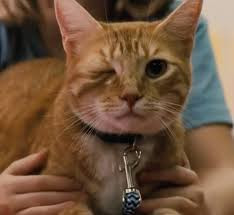Today, let’s delve into the heartwarming movie Gifted and an unassuming character who plays a pivotal role: Fred, the one-eyed orange tabby cat. While Fred might seem like a minor character, he’s actually a masterfully crafted plot device that enriches the narrative and deepens our connection with the protagonist. In the realm of Gifted Movies, Gifted stands out not just for its portrayal of a child prodigy, but also for its subtle yet powerful symbolism. Fred is a prime example of this nuanced storytelling.
Great stories, be they novels, plays, or gifted movies like Gifted, often employ special elements to reveal deeper layers of meaning. Fred is one such element. His presence isn’t just about adding a cute animal to the screen; it’s about enriching the story and forging a stronger bond between the audience and the main character, Mary Adler, a seven-year-old genius.
Gifted centers around Mary, home-schooled by her uncle Frank after her mother’s tragic suicide. The central conflict arises when the question of Mary attending regular school surfaces, a desire stemming from her late mother’s wishes for Mary to have a normal life. However, Mary, fiercely independent and intellectually far beyond her peers, resists this change. Her initial days at school are predictably tumultuous as she clashes with the mundane curriculum, inadvertently revealing her extraordinary mathematical abilities. This revelation sets in motion the central conflict of the movie: a custody battle between Frank, who has lovingly raised Mary, and Mary’s grandmother, Evelyn, who is driven by ambition and a desire to exploit Mary’s genius, much like she seemingly did with her own daughter. Evelyn’s arrival disrupts the fragile normalcy Frank has created for Mary, leading to a tense and emotionally charged legal fight.
The movie’s narrative arc is expertly structured. Around the quarter mark, Frank’s goal becomes clear: he will fight to ensure Mary has a normal childhood and prevent Evelyn from whisking her away to a life solely focused on her mathematical gifts. This sets the stage for a poignant battle where Frank, with limited resources, stands against the formidable Evelyn.
However, to truly appreciate the depth of Gifted, we need to look closer at Fred’s role. Spoiler alert for those who haven’t seen the movie!

Fred’s Importance to the Narrative of Gifted Movies
As the story progresses towards its climax, and after Frank temporarily loses custody of Mary, Fred’s significance becomes undeniably clear. Throughout Gifted, Fred is a constant presence. We see Mary’s affection for him, a gentle side to her often sharp and guarded personality. In fact, one of the earliest instances where Mary softens and displays childlike innocence is when she brings Fred to school for show and tell. This scene offers a glimpse into Mary’s true self, a child yearning for normalcy beneath her extraordinary intellect.
While character arcs often focus on protagonists transitioning from a public persona to their true essence, in Gifted, it’s Mary who undergoes this transformation. Frank remains steadfast in his role as a devoted caregiver. Mary’s journey is about embracing her childhood, a desire often obscured by her brilliance and the external pressures surrounding it.
So, how does Fred fit into this? Screenwriter Tom Flynn skillfully employs Fred as a multifaceted device to enhance the narrative of this among gifted movies.
Firstly, and most obviously, Fred embodies normal childhood. This is the very essence of what Frank and, deep down, Mary desire. When Mary interacts with Fred, whether playing or proudly presenting him to her classmates, she momentarily sheds the weight of her genius. She becomes just a child, enjoying the simple comfort of a pet. Fred becomes a symbol of normalcy, a lifeline to a world where Mary isn’t defined solely by her intellect, but by her capacity for affection and simple joys. For those who understand the comfort animals bring, Fred’s role resonates deeply.
Beyond normalcy, Fred represents something even more profound. He is, in his own way, different. His missing eye sets him apart, much like Mary’s extraordinary intellect isolates her. In a world that often ostracizes those who don’t fit in, Fred and Mary find solace in their shared “otherness.” They are both, in a sense, outcasts, finding comfort and understanding in each other’s company.
Secondly, Flynn cleverly establishes early on that Evelyn is allergic to cats. This detail, initially appearing minor, becomes a crucial plot point. While Evelyn initially attributes her aversion to Frank’s home being “sub-par,” the allergy is a key piece of information subtly planted in the narrative. Pay attention to these details, aspiring writers!
Thirdly, the allergy becomes the very tool Frank uses to expose Evelyn’s manipulative plan. In a moment of despair, after Mary is placed in foster care, Frank stumbles upon an adoption poster featuring Fred – easily identifiable by his distinctive missing eye. The poster reveals that Fred is with Mary in her foster home. This sparks a crucial realization for Frank: Evelyn has orchestrated the foster care arrangement to control Mary, mirroring the pressure she inflicted upon Mary’s mother.
The climax sees Frank in a dramatic “save the cat” moment, literally rescuing Fred from euthanasia at the very last minute. This isn’t just a heartwarming scene; it’s symbolic. Frank isn’t just saving a cat; he’s rescuing the symbol of Mary’s normalcy and happiness from Evelyn’s grasp.

Frank’s actions expose Evelyn’s illegal and unethical maneuvers, enabling him to confront her and ultimately regain custody of Mary. Without delving into further spoilers, the resolution sees Frank ensuring Mary has the balanced life she deserves, nurturing her genius while allowing her to experience the joys of childhood.
Lessons for Writers from Gifted Movies and Fred
Gifted could have functioned without Fred. Mary’s desire for normalcy and Evelyn’s treachery could have been revealed through other means. However, Fred elevates the story through symbolism. Symbols are potent tools in storytelling. Fred, the one-eyed tabby, becomes a symbol of normal life, of a loving home, of warmth and comfort. Rescuing Fred is synonymous with rescuing all these values that he represents.
Consider incorporating symbolism into your own narratives to amplify your themes. In my novel Colorado Promise, for instance, my protagonist, Emma, carries a potted crepe myrtle plant to Colorado. This plant symbolizes her struggle to adapt to a new environment and becomes a recurring motif, reflecting the theme of “blooming where you’re planted.” By the end, when Emma plants the thriving tree, it symbolizes her own flourishing in her new life.
Motifs and symbols can enrich any story. (I delve deeper into this in The 12 Key Pillars of Novel Construction). And remember Fred’s dual role: he is not only symbolic but also a crucial plot device, directly enabling Frank to expose Evelyn.
Think about the inherent symbolism of Evelyn’s cat allergy. If “cats” (specifically Fred) represent a healthy, normal life for Mary, then Evelyn’s allergy signifies her aversion to this very concept. She is “allergic” to Mary having a normal childhood, attempting to eradicate it (symbolically “kill the cat”). However, this very attempt becomes her undoing.
Hopefully, Fred’s example illuminates the power of symbolism in gifted movies and storytelling in general. Are you inspired to create a powerful symbol or motif for your next story? Can you recall other movies or novels where symbolism is employed effectively?


